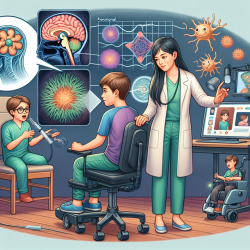Introduction
In the realm of pediatric dysphagia, the accurate detection of aspiration is crucial for preventing adverse health outcomes. The study titled "Using an Automated Speech Recognition Approach to Differentiate Between Normal and Aspirating Swallowing Sounds Recorded from Digital Cervical Auscultation in Children" offers promising insights into improving diagnostic accuracy using machine learning techniques.
Understanding the Study
The research investigates the use of an automatic speech recognition (ASR) approach to distinguish between normal and aspirating swallowing sounds in children. By employing a support vector machine (SVM) classifier, the study achieved an impressive 98% accuracy in differentiating these sounds, with a sensitivity of 89% for aspiration detection.
Implications for Practitioners
For practitioners working with children with feeding disorders, this study provides a compelling case for integrating machine learning into clinical practice. Here are some ways practitioners can leverage these findings:
- Enhance Diagnostic Accuracy: By adopting ASR techniques, clinicians can improve the precision of aspiration detection, thereby reducing the risk of misdiagnosis and subsequent health complications.
- Complement Existing Assessments: ASR can serve as a valuable adjunct to traditional assessments like videofluoroscopic swallow studies (VFSS), offering a non-invasive and repeatable diagnostic tool.
- Facilitate Personalized Care: With more accurate diagnostic capabilities, practitioners can tailor feeding management plans to better suit the individual needs of each child, enhancing overall care quality.
Encouraging Further Research
The study's findings also open avenues for further research in the field of pediatric dysphagia. Researchers are encouraged to explore:
- Broader Applications: Investigate the applicability of ASR techniques across different age groups and types of swallowing disorders.
- Comparative Studies: Conduct studies comparing various machine learning classifiers to determine the most effective methods for aspiration detection.
- Integration with Other Technologies: Explore the potential of combining ASR with other diagnostic tools to enhance overall assessment accuracy and efficiency.
Conclusion
This study underscores the transformative potential of machine learning in pediatric dysphagia diagnostics. By embracing these technological advancements, practitioners can significantly enhance their diagnostic capabilities, ultimately leading to improved health outcomes for children with feeding disorders.
To read the original research paper, please follow this link: Using an Automated Speech Recognition Approach to Differentiate Between Normal and Aspirating Swallowing Sounds Recorded from Digital Cervical Auscultation in Children.










